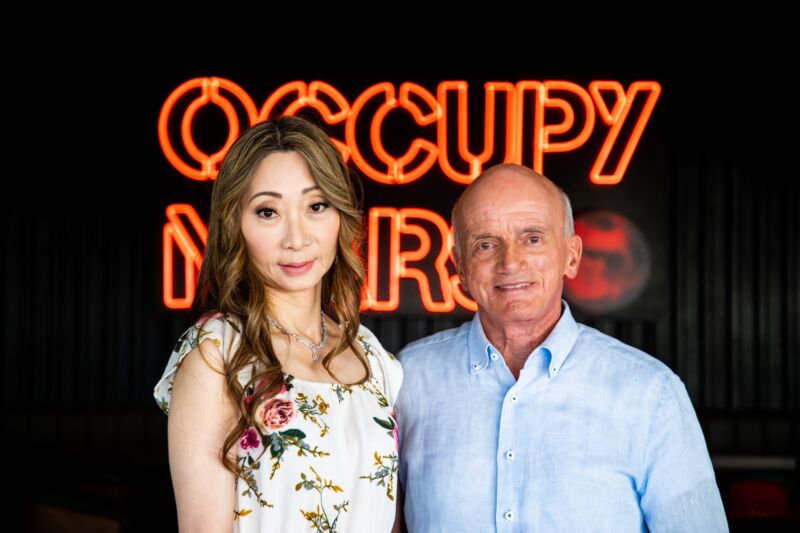
More than two decades have come and gone since entrepreneur Dennis Tito became the first person to pay for his own ride into space, spending a week on the International Space Station.
After that pioneering mission aboard a Soyuz vehicle, Tito said he always had a desire to return to space, with a preference for flying to the Moon. But this thought remained mostly dormant, because Tito did not have confidence in any of the available spaceflight vehicles for such a mission.
That changed about a year and a half ago when he and his wife, Akiko Tito, visited SpaceX's headquarters in Hawthorne, California. After a tour, they discussed possible space tourism trips, and it did not take long for the lunar idea to come up. Would Tito be interested in riding aboard SpaceX's Starship vehicle for a flight around the Moon?
"We looked at each other, and we knew right away," Dennis Tito said this week, during an interview with Ars alongside his wife.
"I said yes, I want to go," Akiko Tito added. "We both wanted to go."
Three missions and counting
The Titos announced Wednesday that they purchased two of a dozen seats on the second of SpaceX's planned circumlunar flights later this decade. With the public announcement, Akiko Tito becomes the first woman confirmed to fly on Starship. The flight will last about a week, outbound to the Moon, passing within about 40 km of the surface and flying back. Ten other seats on Starship remain unsold and are available. Tito said he was not at liberty to disclose the price he paid.
This brings the manifest of private human spaceflights on Starship, and its Super Heavy rocket, to three. There is billionaire Jared Isaacman's Polaris III mission, likely to low Earth orbit, which will be followed by Japanese billionaire Yusaku Maezawa's "dearMoon" flight, the first human Starship flight around the Moon. Then comes Tito and the second circumlunar mission.
SpaceX has also contracted with NASA to fly the first human landing on the Moon as part of the Artemis program, but for now, NASA astronauts will launch on a separate rocket and rendezvous with Starship in lunar orbit to go down to the lunar surface and back to orbit. So far, NASA hasn't announced plans to launch astronauts from Earth on Starship or land them back here.
Waiting on Starship
The timeline for all of these missions hinges on the development of the Starship vehicle, which may make a debut orbital test flight in the coming months from South Texas. After that, the large, fully reusable launch system will fly dozens of uncrewed missions, mostly carrying Starlink payloads, before humans climb on board. This is because Starship will make a propulsive landing back on Earth—something no crew vehicle has ever done—and has no backup should there be some sort of landing failure.
Tito, who recently turned 82 years old, said he is willing to wait. After signing a contract in the summer of 2021, he and Akiko underwent two days of physiological testing and a third day of cognitive tests. "They looked at every possible thing that could be problematic, and it turned out there weren't any problems," he said. "Both of us passed with flying colors."
He acknowledged that age could be a factor. Star Trek actor William Shatner owns the record for being the oldest person to go to space, flying aboard Blue Origin's New Shepard flight last October as a 90-year-old. However, this was just a short, 10-minute suborbital hop. Former NASA astronaut John Glenn remains the oldest person to go into orbit, spending more than nine days aboard the space shuttle at the age of 77 in 1998.
Given the amount of development work ahead of it, Starship is unlikely to be ready for crewed circumlunar trips before 2025, and that date probably will slip later into the decade. "My personal timeframe is that we're willing to wait for as long as we're healthy," Tito said. "We can't force the timeline. It will happen when it happens."
Tito's announcement came during a visit to SpaceX's Starbase facility in South Texas, where the company is assembling Starship prototypes and testing the vehicles. Tito said he has been following the progress of development there on YouTube and called the launch and test facilities "amazing."
“Nothing happened”
After Tito's first trip to space in April 2001, six other people launched on a Soyuz through 2009, for $20 million to $30 million a trip. Then, for a decade, there was no space tourism at all. Tito said he had hoped the private spaceflight industry would blossom, with the price of an orbital trip coming down to $1 million per person.
"It dried up and nothing happened," Tito said. "I thought there would be hundreds of people going into space. It was kind of disappointing. Now all of a sudden with the development of reusability, I think it’s finally happening. We’re just excited as can be."
Starship, he said, could be the vehicle that opens access to more people. While there is capacity for a dozen people on the first lunar missions, the spacious vehicle could accommodate dozens more, especially for trips to Earth orbit. The key, he said, will be SpaceX's ability to deliver a fully reusable Starship and large volumes of flights to spread out the operations costs.
But for that to happen, some people will have to go first, paying higher prices and assuming a greater risk. That's where Isaacman, Maezawa, and now the Titos come in.
reader comments
169